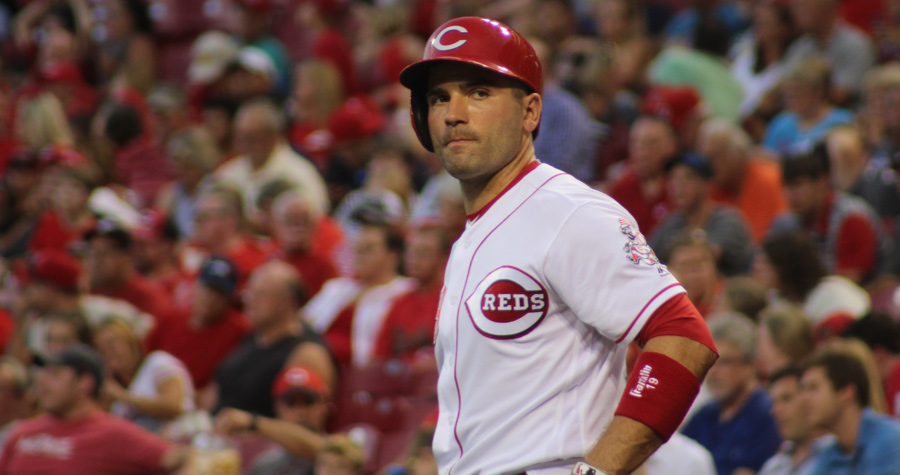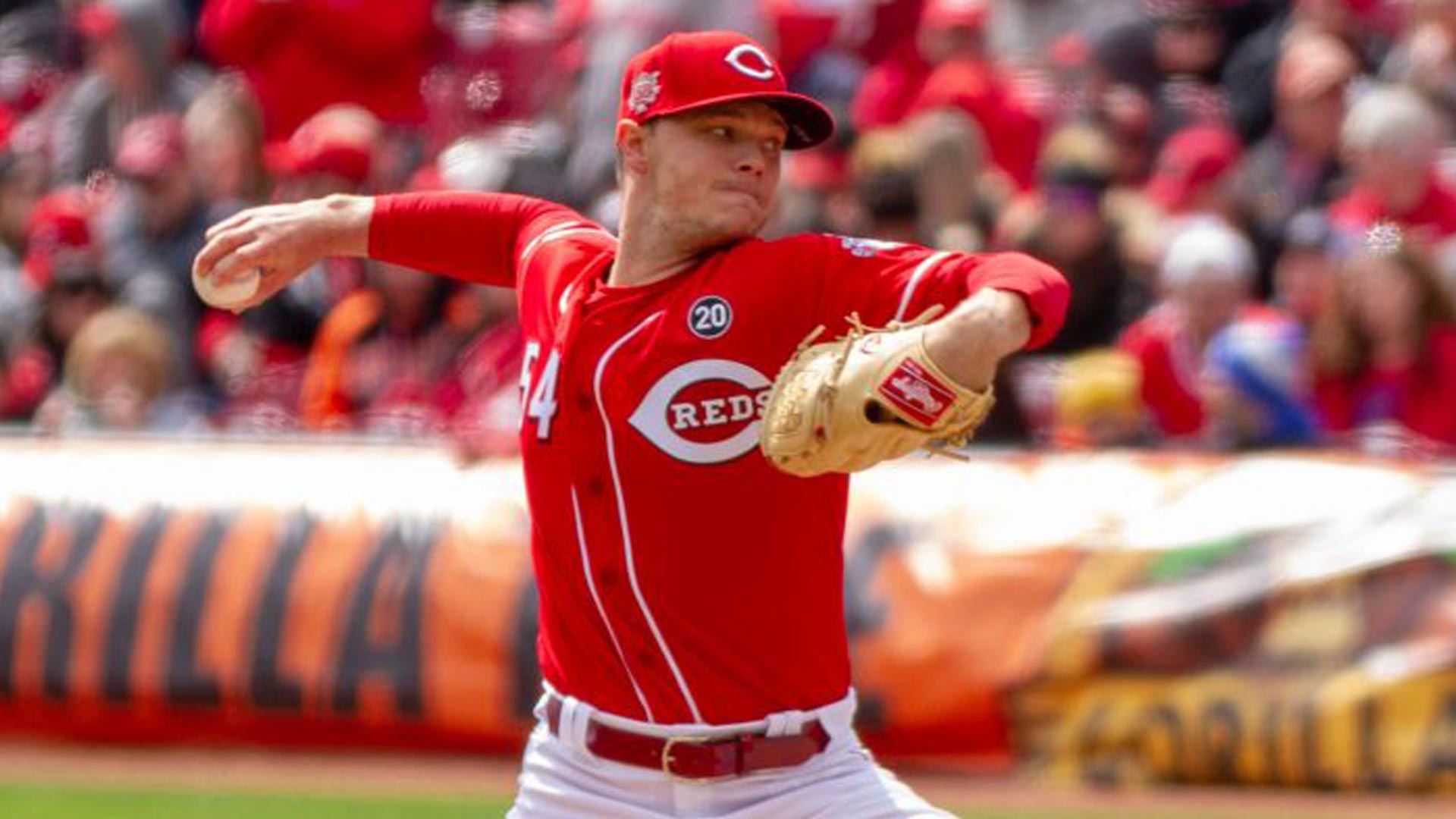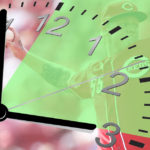He Hate Me
Joey Votto is the best hitter to ever wear a Cincinnati Reds uniform. Why do so many people want to run him out of town?
. . .
He reached the summit at 10:07pm on August 13, 2016. It was — and remains — a remarkable achievement, given that on May, 31st, a full two months into the season, he was still bivouacked at his own personal base camp, disoriented by muscles and memory rendered insufficient by opposing forces on the hill some sixty feet away. A .213 batting average, a .330 on-base percentage, not to mention a month of April that was the worst of his career weren’t just base camp for Joey Votto — this was the basement of a career that has seen him among the very best hitters in Major League Baseball.
And yet, despite the horrid start, there he was on this torrid summer night, back over .300, that sentimental number that confers hitting excellence to eight year-old boys and ink-stained sportswriters alike. By the next morning, his official slash line stood at .303 (BA)/.429 (OBP)/.514 (SLG). His wRC+ (weighted runs created plus) — a stat meant to convey the totality of a player’s offensive output — would now stand at 149, meaning he was a very fine 49% better than the average major league hitter.
That’s saber-shorthand for “elite.”
Votto had a similar, if less dramatic year in 2015, pairing middling numbers in the first half with a fast and furious second half that earned him a third place finish in the NL MVP voting.
Votto’s career numbers — now approaching a full decade — track a clear path up the New York Thruway, heading straight toward the doorstep of 25 Main Street, Cooperstown, New York. A former league MVP, his lifetime batting average is a Hall-welcoming .311. If power is your raison d’être, his .533 slugging percentage ranks higher than Mike Schmidt and, yes, Willie Stargell. Now, one would hardly go so far as to say that Votto is the power hitter Stargell was. After all, Pops amassed that number across 21 seasons. But for a player who hits for average and gets on base at a career rate that puts him in the company of names like Williams, Ruth, Cobb, Speaker, Gehrig, Bonds and Hornsby — that’s powerful stuff.
But for many in Cincinnati, it just isn’t good enough.
Looking through my archives…..caller on April 21 wanted Votto sent to Louisville.
— Lance McAlister (@LanceMcAlister) August 24, 2016
@m_sheldon Votto likes to Chit-Chat at first instead of being in the game. Both offense & defense..costly
— luke mccoy (@bill3853) August 31, 2016
If your old analog car antennae was up and you were cruising around Cincinnati during afternoon drive time on a certain sunny day this summer, you could have heard a local afternoon talk radio guy — working for the very station that carries Reds games — label Votto “mentally ill.”
Good grief.
. . .
“Beware the fury of a patient man” — John Dryden
You cannot speak of Joey Votto without invoking the numbers — they are so gobsmackingly brilliant. Yet, the paint-by-numbers approach to drawing a portrait of Votto, while wildly impressive, is still found lacking. Only a true color study of the subject fills out the portrait and renders a more complete picture of, yes, let’s just say it: the finest hitter to ever step into a Cincinnati Reds’ uniform.
Like Nick Saban, one of the great college football coaches of our day, Votto believes in this thing you may have heard of: Process over Results. Just as Saban’s players are instructed to concentrate on the seven seconds that are the length of an average football play, focusing on technique and execution while shutting out the scoreboard — Votto too, shuns the extraneous, focusing on the moment itself, all in service of putting the barrel of the bat on pitches that arrive in a very specific place: “the joey zone,” not merely that etch-a-sketch of a strike zone redrawn each day as a different umpire unpacks his wares behind home plate. Yes, the great ones think alike, don’t they?
The Batmatician explains it all for you:
“Instead of me practicing hitting singles you know, up-and-in, low-and-away and MAYBE getting a double, I want to take swings that result in extra base hits or home runs every single time I swing. I want to know that I’m going to put a barrel on a ball, I want to know that when I face Clayton Kershaw in the eighth inning and he throws a ball in specific part of the strike zone that I’m going to put a barrel on it and give us a good chance of making contact and helping the team out. I think not wasting swings helps me be better and will help us play better as a team.”
Patience is his soulmate. His work ethic is largely unknown to a fan base passing through the turnstiles moments before the players take the field. He is — nod to Don McLean here — very much the marching band that refuses to yield. When other players are in the clubhouse, he remains, taking ground balls in solitary repetition; he toils with hitting coach Don Long, identifying any remaining weaknesses in an otherwise remarkable swing. When a rare slump does arrive, he searches for inspiration in the long history of the game, from Ted Williams to the website Baseball-Reference. No zone is left unturned, from the O-Swing zone to the Z-Contact zone.
With the exception of a 2012 meniscus tear that interrupted another record-setting pace of a season (he was picking up doubles like Beyonce picks up Twitter followers) and a debilitating quadriceps injury in 2014 that ended his year prematurely, he’s a workhorse who plays nearly every day, averaging 158 games in four other seasons since 2009. He’s on pace to play in 157 games this year.
The hole in his game has been his fielding. His glove puts a ding in his overall WAR value. To his credit, he’s spent countless hours turning himself into a capable fielder, even winning a Gold Glove. Still, his defense remains a work-in-progress.
After his disastrous 2014 season, he went home to Etobicoke (the western part of Toronto) to heal and rehab amongst friends and family. Like a safe room, fortified against the elements, Votto found a place to relax, recharge and reflect:
“Toronto became my sanctuary,” Votto said. “I’m so lucky to be from here. It’s so beautiful. I visit the best cities in the world with my job when the Reds are on the road: New York, Chicago, Los Angeles, Miami, Dallas and Atlanta.
“I recognize how appealing they all are, but it’s not home. My city competes well with those cities. When I’m in the U.S., they see me a certain way … In Toronto they see me as a guy they went to school with. I’ve never felt as comfortable in the other cities as I do at home.”
. . .
Votto’s knowledge of the strike zone is unparalleled. Had he been born three-quarters of a century ago, umpire Bill Klem might have said to a young, frustrated pitcher, “Son, when you pitch a strike, Mr. Votto will let you know.”
Catcher and former teammate Dioner Navarro, who knows a little about attacking hitters, speaks to the granularity of Votto’s process:
“The one thing I’ve learned is that he doesn’t follow any patterns. He’s such a smart hitter, he’s making adjustments to the adjustments the pitchers are making to him, and he’s doing that in-game. Most major leaguers make adjustments out to out. He’s making them during the at-bat.”
For many in the herd who get their marching orders from social media misanthropes, all this gets lost amid old baseball biases and tired agendas. Each day, Votto takes his metaphorical place in the dunking tank, the naysayers with their weak fastballs at the ready. It’s the haters who are all wet.
@Reds Joey Votto is the most overpaid player ever if we never paid him we would of still had a great team
— Matthew Anderson (@mattanderson116) June 29, 2016
@AndrewSimonMLB Never heard anyone say Kris Bryant is overrated. He doesn’t get the Votto treatment.
— M (@TisdaleDr1978) July 5, 2016
Please retire already votto…u r a bum
— courtland clay (@cc205995) June 16, 2016
The 2010 MVP is a high-performance automobile enthusiast. Hearing the criticism of his slow 2016 start, he conjured what was for him, a comfortably familiar analogy:
“My swing is a fine piece of machinery. Everybody wants to rush the Ferrari, but it comes out every four to six years. It takes time.”
This local fan response was not atypical:
“Well when your playing like an Edsel people take notice. I like Votto but he comes across as having mental issues. When I was in baseball Will Clark and Ted Simmons were two ballplayers who did not have the sharpest mental tools in the wood shed. I believe Joey may be borrowing from the same shed.”
And that guy actually “likes” Votto.
When Bryan Price was named manager, Votto was criticized for not immediately weighing in on the hiring. When the Reds first baseman was crippled with a distal quad injury that kept him out of the lineup for 100 games in 2014, his toughness was called into question.
“I feel like I’ve been the one in the crosshairs,” he [Votto] said. “I’ve noticed little comments here and there and just a general perception that this is something I elected to do. I didn’t elect to be injured. I am injured.”
When Votto took time off because of stress following the sudden death of his father — his manhood was impugned. His response was sobering:
“He was the first one to teach me how to play baseball. He loved me and what I did… The two most important sides were tugging on me, baseball and my father. I just gave way. I could not escape it.”
Perfect, Votto is not. He’s a private sort, a quality that lends to misunderstanding. However, again and again throughout the years, he’s shown himself to be a thoughtful and kind athlete, which, if we are honest, doesn’t always move the needle with a media that overvalues the rambunctious voice over the restrained one. He desperately wants to please the fans and has said so publicly. When he recently had a run-in with a Reds patron while reaching for a foul ball, instead of doing the usual “If I Offended Anybody” non-apology apology, Votto manned up:
“I misplayed it. And I took my frustration out on a fan. First of all, I should have made the catch regardless. He stayed in the stands. I crossed the boundary and touched his shirt, so I felt really bad about it afterwards. Randy … he was generous enough to apologize at the time and afterwards. In retrospect, he’s not the one who should be apologizing. I should be apologizing. I’m just trying to catch a ball and here I am bullying him … I was in the wrong completely there.”
On those rare occasions when Votto has gotten heated with an umpire, you wouldn’t know that baseball is a game where player and manager rants are not merely accepted, but actually revered as part of the rich culture of the game. No, the Reds’ superstar is held to a different standard, garnering criticism usually reserved for a golfer caught moving his ball or a wayward child.
His quirky and sometimes wicked sense of humor led him to appear for an interview wearing a Canadian Mountie uniform, and more recently, have 51 boxes of pizzas Uber-delivered from a Louisville restaurant 100 miles away to the Great American Ball Park locker of Ichiro Suzuki. It’s also provoked a bit of fun on the road with some inebriated adults heckling from behind first base, resulting in a soulless villain caricature, the kind who steals ice cream from small children.
. . .
Standing on a subway platform, I watch two New York City Metropolitan Transit Authority workers as they run electrical pipe across the ceiling and down to a kiosk mounted on the floor below. A young worker stands on a ladder, adjusting the pipe running to the kiosk, making sure the pipe is exactly perpendicular to the ceiling. Another older, veteran worker supervises from the floor a few feet away, eyeballing the younger man’s work, as the latter taps the conduit with a hammer, keeping his eyes on the level magnetically attached to the pipe. The young man stops tapping, satisfied with the information provided by his tool.
“More. More,” orders the older man. The young man looks at the level, then at his co-worker, wondering aloud what he could possibly be seeing. The older man shakes his head, his displeasure in grim solidarity with the sardonic smile creeping across his face.
And there it is, a perfect real world analogy for the gulf between the analytic observer and the old school “eye test” devotee. Therein defines the DMZ line between those that appreciate the genius that is Joey Votto — and those that don’t.
New School versus Old School long ago hijacked the baseball conversation in Cincinnati, putting Joey Votto on the witness stand while counselors from both sides cross-examined OBP Joey, then RBI Joey. The defense insisted that baseball forensics won the day. That worn, old school baseball glove didn’t fit, so baseball must acquit OBP Joey of crimes against the game, even as the losing side continues to demand a retrial in the uncivil court of public opinion.
In Cincinnati, the Old School Headmaster is Reds radio play-by-play announcer Marty Brennaman, a man whose contempt for advanced metrics is well-documented. Modern day numbers are the seed that finds no purchase in the Reds radio booth. Brian Kenny, Director of the Department of Decision Sciences at MLB Network, has bestowed upon Votto the title “The Prince of Process,” placing him, as player, at the vanguard of the advanced metric movement. That title is not lost on the Voice of the Reds.
From his pulpit on the Ohio River, Marty’s Greatest Votto Hits are a veritable discography of disdain. He’s said Votto “isn’t paid to walk. He’s paid to drive runs in.” Two spring trainings ago, he declared: “if this guy comes back and is content to lead the league in OBP again, then this team is in deep trouble.” In the summer of 2015, he proclaimed Votto no longer “elite” based on, of all things, his RBI output — three months before he would go on to finish third in the MVP voting. This summer, after Votto made a perceived mental error defensively at first base, Brennaman, in a fit of snark, suggested he was perhaps “preoccupied with his on base percentage.”
Brennaman’s business card says “TELLS IT LIKE IT IS” in bold Helvetica type. That style, along with other attributes, has won him the Baseball Hall of Fame Ford C. Frick award. It’s made him a National Sportscasters and Sportswriters Association Hall of Fame inductee; and a National Radio Hall of Fame inductee. For those who have spent decades listening to Marty Brennaman, the cognitive dissonance of the brilliant play-by-play and the obsession with taking Votto and everything he stands for down a peg is deeply painful. The accusations blare across the airwaves as discordant notes played by a gifted musician. This we know: the radio voice of the Reds is no bar mitzvah singer. Rather, he’s Springsteen singing off-key.
The criticism trickles straight down to the masses. It’s not always about Geeks vs. Gatekeepers. Some folks don’t have the time or inclination. They simply take their cues from the maestro behind the mic. This is Cincinnati and he is Marty Brennaman, after all.
Brennaman is far from alone. From the All Star break to Labor Day, Votto’s slash line read an astounding .426/.526/.677 with a wRC+ of 212. Appearing on the MLB Network, New York Post columnist Joel Sherman recently redacted Votto’s 2016 achievements, suggesting they occurred in the crucible that is the Reds’ rebuilding season — or what Sherman referred to as “garbage time.” In Sherman’s world, meaningful achievements occur only in pennant races or relevant big cities, not in environments where Votto, or say, Mike Trout toil, far from the madding crowd.
The New York Mets and Keith Hernandez recently came to Great American Ball Park. Each time he sees the 2010 MVP, Hernandez, the SNY cable TV color analyst, never fails to inform his New York audience that “Joey Votto thinks too much” at the plate. That Votto would be the best offensive player on the Mets in 2016 — or perhaps any season in recent memory — holds little sway with the erstwhile Cardinal and Mets first baseman:

Even the good folks at Fangraphs — my go-to site for smart baseball analysis, who routinely show solidarity with Votto and his process — had a recent online chat that included a short discussion on the possibility of the Reds’ first baseman being traded at the August 31 deadline to the Yankees or Phillies with a moderator opining: “They love old declining 1B.”
Ouch. Say it ain’t so, FG.
. . .
It doesn’t help that Votto signed a contract extension that pays him $250M over twelve years shortly before the competitive window closed on the Reds, leaving Votto the anchor of a rebuilding team. Sabermetric WAR tells us that Votto is outperforming his contract, but folks not enrolled at Saber U. are let’s just say, “skeptical.” There’s little question that Votto’s plate discipline skills will age well. His work ethic even suggests he might be able to keep Father Time at bay well into his thirties. But advanced metrics project a gradual decline in player performance each year after a player reaches the apex of the aging bridge at 30, because, on average, this is how players do. It’s called the dreaded “decline phase.” So far, there’s nothing in Joseph Votto’s bat at age 32 that hints at the inevitable.
All the fans know is that the Reds haven’t won a playoff series in over twenty years. The latest window has closed. The band has been broken up, but the lead singer remains, older — and mostly alone, continuing the fight, teaching younger pups like Billy Hamilton a winning tune. The Reds are about to sign a new TV contract and nobody knows what that will look like. Player salaries continue to go up with little sign of abating, making Votto’s eventual $25M a year payout look less ostentatious with each passing season. Still, many fear the depreciation won’t be enough and the first baseman’s contract will anchor the club to the basement of the division for years to come.
You only need to look to his immediate right to grasp the double-standard Votto plays under. It’s difficult imagining the PR hit Votto would take were he to call the team owner a “liar” or brutally berate a local reporter on video, as Brandon Phillips once did. The gregarious Phillips remains a favorite, fan-friendly and accessible via social media and in person. Phillips’ personality runs counter to Votto’s natural shyness, a quietness that can play into the perception of aloofness. The Reds’ second baseman is perceived as more willing to play through injury. Astonishingly, his RBI totals are viewed by many as being more valuable than the sum of Votto’s offensive contributions.
BP = Gritty RBI. He should be hitting third instead of Votto, who chooses to not have anybody on base when he hits. #Reds
— Mad Cincy Fan (@MadCincyFan) September 17, 2016
The combination of the money, the expectations, the almost iconic role as player/leader of an analytical movement hated by many — all embodied by an introspective athlete who holds close his privacy — have created a personae that has led him to become the most polarizing player ever to play for the Reds.
. . .
So, the war on Joseph Daniel Votto continues. It extends beyond the boundaries of baseball’s unwritten rules, where straying from the herd is verboten. It manifests itself beyond new school versus old school, crossing the foul line and metastasizing onto the playing field of life, where so many tend to be suspicious of those who walk a different path.

The Batmatician goes about his business at the plate with an air of unhurried confidence, his at-bat routine practiced and precise. His stare between pitches is not the usual vacant thousand-yard stare, but rather the look of a man locked in to his process, the non-believers relegated to that undiscovered country where mere mortals fret and fust, out of sight and out of mind. A good man, he wants your appreciation, yearns for it even, truth be told. But nothing interrupts the work, the step-by-step mechanics of perfecting the always imperfect, and in doing so, rediscovering himself once more. He waits on his adversary. He steels the battlements. He uncoils and commits to the pitch.
Then, the process starts all over again.







3 Comments
Only lost me at the bakery a couple of times, Richard. But I feel smarter for it. Some of us Reds fans appreciate the marvel that is Joey Votto. Always following his muse, as it were. Thank you, excellent piece.
September 22, 2016 at 9:10 am[…] written this, and this, and this, and this about Votto. Before all is said and done, I’ll surely make it a […]
October 4, 2016 at 1:39 pm[…] It turned out to be the first really big moment for the owner of the Cincinnati Reds, a symbolic, but meaningful stepping-stone on his promise to bring winning baseball back to a town starved for it. The national media—and even some locally—would trample on the signing, insisting the small-market Reds—like Donny Kerabatsos—were out of their element. No matter. The owner passed his first test and Joey has held up his end of the bargain in spectacular fashion, trammeling up the haters. […]
July 20, 2020 at 7:18 pm